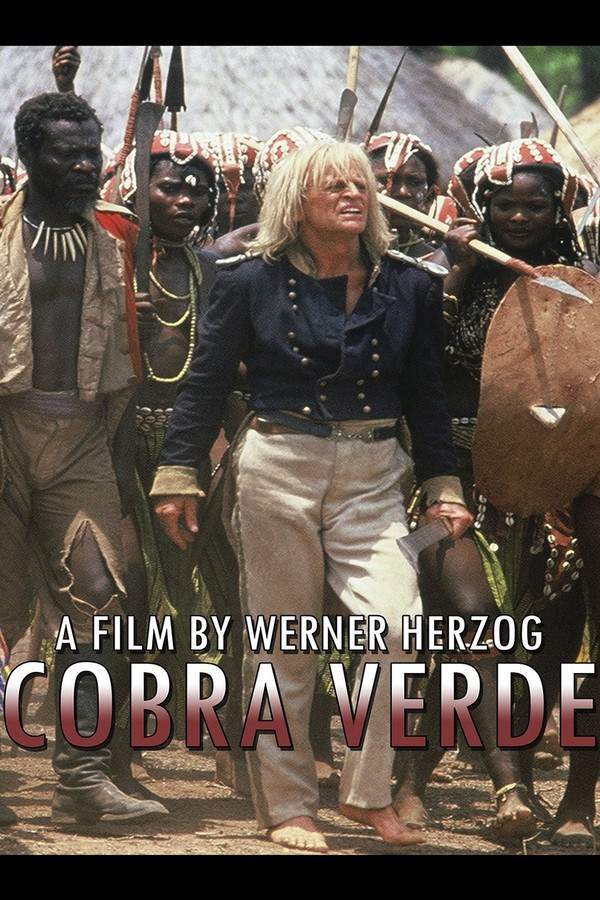Cobra Verde 2007

A compelling adventure film, Klaus Kinski portrays Francisco Manoel da Silva, a resourceful Brazilian seeking fortune in West Africa. He employs both shrewdness and charisma while navigating the region’s intricate power dynamics. Initially involved in the slave trade, Francisco’s ambitions lead him to a surprising contest for royal authority, exchanging plantation chains for the trappings of a king.
Does Cobra Verde have end credit scenes?
No!
Cobra Verde does not have end credit scenes. You can leave when the credits roll.
Meet the Full Cast and Actors of Cobra Verde
Explore the complete cast of Cobra Verde, including both lead and supporting actors. Learn who plays each character, discover their past roles and achievements, and find out what makes this ensemble cast stand out in the world of film and television.
No actors found
External Links and Streaming Options
Discover where to watch Cobra Verde online, including streaming platforms, rental options, and official sources. Compare reviews, ratings, and in-depth movie information across sites like Wikipedia, Rotten Tomatoes or Metacritic.
Ratings and Reviews for Cobra Verde
See how Cobra Verde is rated across major platforms like IMDb, Metacritic, and TMDb. Compare audience scores and critic reviews to understand where Cobra Verde stands among top-rated movies in its genre.

55
Metascore
7.6
User Score


83%
TOMATOMETER

75%
User Score
Take the Ultimate Cobra Verde Movie Quiz
Challenge your knowledge of Cobra Verde with this fun and interactive movie quiz. Test yourself on key plot points, iconic characters, hidden details, and memorable moments to see how well you really know the film.
Cobra Verde Quiz: Test your knowledge on the film Cobra Verde, a tale of ambition, treachery, and the complexities of the slave trade.
Who is the main character of Cobra Verde?
Francisco Manoel da Silva
Dom Octávio Coutinho
King Bossa Ahadee
Taparica
Show hint
Full Plot Summary and Ending Explained for Cobra Verde
Read the complete plot summary of Cobra Verde, including all major events, twists, and the full ending explained in detail. Explore key characters, themes, hidden meanings, and everything you need to understand the story from beginning to end.
In the late 19th century, we meet Francisco Manoel da Silva, portrayed by Klaus Kinski, a hedonistic Brazilian rancher forced into labor at a gold mining company after drought devastates his ranch. His troubling realization of being financially exploited leads him to a shocking act—he murders his boss and becomes an outlaw known as Cobra Verde (or Green Snake), gaining notoriety as the most brutal bandit in the sertão.
While visiting a local town, da Silva encounters and subdues an escaping slave through sheer force of will, capturing the attention of the affluent sugar baron, Dom Octávio Coutinho, played by José Lewgoy. Unbeknownst to Dom Coutinho, da Silva is the infamous bandit he just hired to manage the slaves on his plantation. Tension escalates when da Silva’s reckless liaisons result in the pregnancies of all three of the baron’s daughters. Outraged, Dom Coutinho decides that instead of execution, he would punish da Silva by sending him on a perilous mission—to re-establish the slave trade with Western Africa.
Understanding the dire consequences that await him in Africa, da Silva nonetheless accepts the grave undertaking. His perilous journey takes him to Dahomey, which is present-day Benin, where he has to deal with the formidable King Bossa Ahadee, brought to life by the Honorary Omanhene Nana Agyefi Kwame II of Nsein, near Axim, Ghana. To everyone’s surprise, da Silva persuades the King to trade slaves for new rifles.
He seizes control of Elmina Castle and aligns himself with King Ampaw, the last survivor of his previous mission. Together, they embark on the harrowing venture of transporting enslaved individuals across the Atlantic to Brazil. Yet fortune swiftly turns, as the capricious king has them apprehended on dubious charges, including the absurd accusation of poisoning his greyhound, and orders their execution.
Just before his imminent demise, da Silva and King Ampaw are saved by the King’s nephew, who seeks to forge a blood alliance with da Silva to destabilize the ruling King. In an unexpected turn of events, the ambitious bandit trains a formidable army of native women, who are initially intent on exterminating all men, and leads a successful assault against King Bossa.
Miraculously, under the new monarchy, the slave trade persists, aided by da Silva’s cunning. However, the bandit soon finds himself at odds with the new king. He learns that his homeland of Brazil has abolished slavery and confiscated his holdings, with the British now placing a bounty on his head. Despite facing numerous challenges, da Silva expresses a sense of relief knowing that a vital change has unfolded, acknowledging the horrific crime that slavery truly is.
In a poignant closing scene, the weary outlaw stumbles onto the beach at Elmina, attempting to drag a ship’s boat toward the surf. As he collapses in despair, the tide begins to rise, and a crippled African man approaches him, crawling along the shore. The film concludes with a vibrant image of young African women joyfully chanting, a symbol of hope and resilience as the credits roll.
Uncover the Details: Timeline, Characters, Themes, and Beyond!

Coming soon on iOS and Android
The Plot Explained Mobile App
From blockbusters to hidden gems — dive into movie stories anytime, anywhere. Save your favorites, discover plots faster, and never miss a twist again.
Sign up to be the first to know when we launch. Your email stays private — always.
Discover Film Music Concerts Near You – Live Orchestras Performing Iconic Movie Soundtracks
Immerse yourself in the magic of cinema with live orchestral performances of your favorite film scores. From sweeping Hollywood blockbusters and animated classics to epic fantasy soundtracks, our curated listings connect you to upcoming film music events worldwide.
Explore concert film screenings paired with full orchestra concerts, read detailed event information, and secure your tickets for unforgettable evenings celebrating legendary composers like John Williams, Hans Zimmer, and more.



Unlock the World of Movies with Our Comprehensive Wiki
Dive into our Movie Wiki for in-depth film encyclopedia entries, including cast biographies, production trivia, plot synopses, behind-the-scenes facts, and thematic analyses. Whether you’re researching iconic directors, exploring genre histories, or discovering hidden easter eggs, our expertly curated movie database has everything you need to fuel your cinematic passion.

Quick Links: Summary, Cast, Ratings, More

What's After the Movie?
Not sure whether to stay after the credits? Find out!
Explore Our Movie Platform
New Movie Releases (2025)
Famous Movie Actors
Top Film Production Studios
Movie Plot Summaries & Endings
Major Movie Awards & Winners
Best Concert Films & Music Documentaries
Movie Collections and Curated Lists
© 2025 What's After the Movie. All rights reserved.










